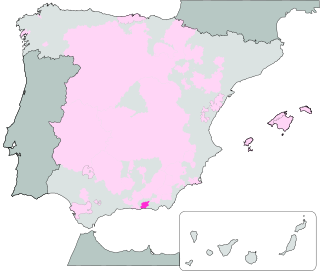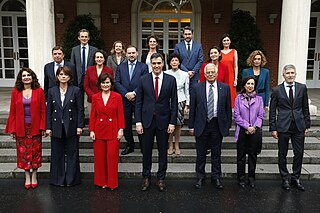
Chile has a long history in the production of wine, with roots dating back to the 16th century when the Spanish conquistadors introduced Vitis vinifera vines to the region. In the mid-19th century, French wine varieties such as Cabernet Sauvignon, Merlot, Carmenère, and Franc were introduced. During the early 1980s, the Chilean wine industry underwent a renaissance with the introduction of stainless steel fermentation tanks and the use of oak barrels for aging. This led to a rapid growth in exports as quality wine production increased. The number of wineries in Chile rose from 12 in 1995 to over 70 in 2005.

Mendoza, officially the City of Mendoza is the capital of the province of Mendoza in Argentina. It is located in the northern-central part of the province, in a region of foothills and high plains, on the eastern side of the Andes. As of the 2010 census [INDEC], Mendoza had a population of 115,041 with a metropolitan population of 1,055,679, making Greater Mendoza the fourth largest census metropolitan area in the country.

The Libertador General Bernardo O'Higgins Region, often shortened to O'Higgins Region, is one of Chile's 16 first order administrative divisions. It is subdivided into three provinces. It is named in honour of Bernardo O'Higgins Riquelme, one of Chile's founding fathers.

Cueca is a family of musical styles and associated dances from Chile, Argentina, and Bolivia. In Chile, the cueca holds the status of national dance, where it was officially declared as such by the Pinochet dictatorship on September 18, 1979.
The escudo was the currency of Chile between 1960 and 1975, divided into 100 centésimos. It replaced the (old) peso at a rate of 1 escudo = 1000 pesos and was itself replaced by a new peso, at a rate of 1 peso = 1000 escudos. The symbol Eº was used for the escudo.

National Route 9 is a major road in Argentina, which runs from the center-east to the northwest of the country, crossing the provinces of Buenos Aires, Santa Fe, Córdoba, Santiago del Estero, Tucumán, Salta and Jujuy. It starts on Avenida General Paz, which marks the border between the Autonomous City of Buenos Aires and the surrounding province of the same name, and ends at the Horacio Guzmán International Bridge, on the La Quiaca River, traversing 1,967 km (1,222 mi). The road is a limited access motorway from Buenos Aires to Rosario.

Santa Cruz is a Chilean city and commune, located in the Colchagua valley, in the O'Higgins Region, located on the southern shore of the Tinguiririca river, 110 miles from Santiago, Chile's capital city, and 27 miles from San Fernando.

Cumbres del Guadalfeo is a Spanish geographical indication for Vino de la Tierra wines located in the Alpujarras mountains, in the autonomous region of Andalusia. Vino de la Tierra is one step below the mainstream Denominación de Origen indication on the Spanish wine quality ladder.

Guido Girardi Lavín is a Chilean doctor and politician. He was a senator in district no. 7 for Santiago Poniente. He previously served as the president of that chamber.
Vino de Pago is a classification for Spanish wine applied to individual vineyards or wine estates, unlike the Denominación de Origen Protegida (DOP) or Denominación de Origen Calificada (DOCa) which is applied to an entire wine region. The Vino de Pago classification was introduced in 2003 by a decision in the Cortes Generales, the Spanish parliament, to help further improve the quality of Spanish wine. As of 2021, there were 20 Vinos de Pago.

The first government of Pedro Sánchez was formed on 7 June 2018, following the latter's election as Prime Minister of Spain by the Congress of Deputies on 1 June and his swearing-in on 2 June, as a result of the success of a motion of no confidence against Mariano Rajoy. It succeeded the second Rajoy government and was the Government of Spain from 7 June 2018 to 13 January 2020, a total of 585 days, or 1 year, 7 months and 6 days.

The National Congress of Nicaragua was the legislature of Nicaragua before the Nicaraguan Revolution of 1979.

The Austral wine region is one of the six official wine regions of Chile. The region is recognised by Decreto de Agricultura nº 464 of 14 December 1994, which established the regions and rules of origin. Chilean wine using the label Austral must have at least 3/4 of its content made in the Austral Region.

The first government of Mariano Rajoy was formed on 22 December 2011, following the latter's election as Prime Minister of Spain by the Congress of Deputies on 20 December and his swearing-in on 21 December, as a result of the People's Party (PP) emerging as the largest parliamentary force at the 2011 Spanish general election. It succeeded the second Zapatero government and was the Government of Spain from 22 December 2011 to 4 November 2016, a total of 1,779 days, or 4 years, 10 months and 13 days.

The second government of Mariano Rajoy was formed on 4 November 2016, following the latter's election as Prime Minister of Spain by the Congress of Deputies on 29 October and his swearing-in on 31 October, as a result of the People's Party (PP) emerging as the largest parliamentary force at the 2016 Spanish general election. It succeeded the first Rajoy government and was the Government of Spain from 4 November 2016 to 7 June 2018, a total of 580 days, or 1 year, 7 months and 3 days.

Urban Wetlands Law is a Chilean law regulating wetlands in urban areas. The law intends to provide a set of "minimal criteria for the sustainability of urban wetlands, safeguarding its ecological characteristics and their functioning, and to maintain the hydrological regime, both on surface and under the ground".

Colchagua was a province (region) of Chile between 1826 and 1976. Its capital was located in San Fernando during most of its existence. For some years, Curicó and Rancagua were capitals of Colchagua.
Viña Emiliana is a vineyard and winery, founded in 1986, in Casablanca, Valparaíso Region, Chile. In 2015 it had more than 800 organic hectares of vineyards, distributed among the valleys of Casablanca, Maipo, Cachapoal, Colchagua, Biobío and Limarí, as well an annual export of 700,000 cases in 2016, it sold in 60 countries, being its main destinations: United States, Netherlands, Denmark, China and Canada.

The Instituto de Turismo de España – Turespaña, is the official agency of the Government of Spain responsible for the marketing of the country as a tourist destination throughout the world. It depends on the Ministry of Industry, Trade and Tourism through the Secretary of State for Tourism.


















